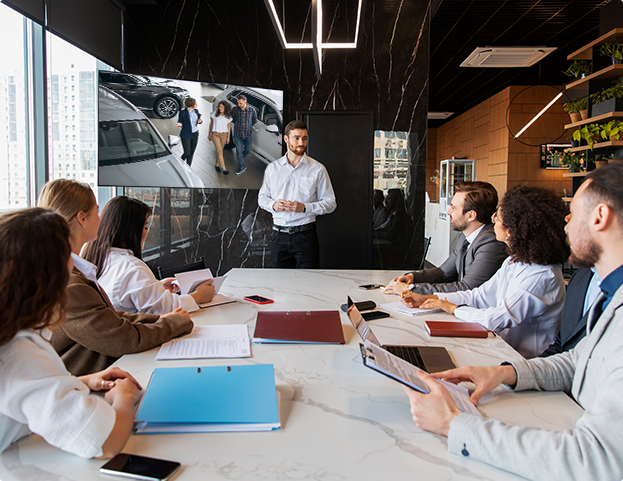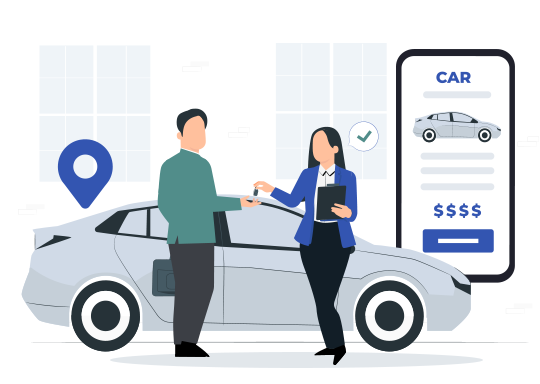We live in an age where e-commerce has become the norm, and virtual stores are just as vital as brick-and-mortar stores. Car dealership are slowly catching up with this reality. With 85% of consumers using the web to look for new cars, it is only natural that car dealerships pay attention to their digital stores.

Let’s look at the car buying process – a crucial part of automotive marketing. This journey includes everything from the minute the customer interacts with your dealership to where they make the actual purchase.
This process has also been impacted and has evolved due to changing consumer demands, the digital revolution, and the pandemic that changed everything for the world. Now more than ever, understanding and communicating this process effectively is crucial. After all, if your dealership’s website isn’t answering the right questions, your potential buyers might be gone before you know it.
The car buying process is a virtual joyride with many stops and starts. Let’s examine this journey, answering five crucial questions every car dealership website should address. We’ll also delve into the exciting world of remote car buying, a trend accelerated by recent circumstances and shows no signs of decelerating.
The Shift to Digital: Understanding the Car Buying Process
1. What is the Car Buying Process?
Simply put, the car buying process begins when a customer decides they want a new car to when they ride off into the sunset with their new car. The multi-stage process includes recognizing vehicle needs, researching and comparing, negotiating, and then purchasing. While this process seems very simple, it has become quite complicated in the age of digital media, where potential car buyers have become more aware of their options now than ever.

The car buying process is actually a peculiar combination of consumer behavior, economic factors, and technological advancements. A good car dealership understands this and adjusts its marketing strategy accordingly.
2. Remote Car Buying – Is it The New Norm?
You know what they say, change is the only constant. The automobile industry is no exception to this rule. The rise of the internet and digital tools has given birth to a new trend: remote car buying. According to a recent study by McKinsey & Company, over 75% of buyers are now open to completing their car purchasing journey online, from start to finish.
Remote car buying is self-explanatory – it allows consumers to buy a car from the comfort of their homes. It includes every process step – browsing through online inventories, arranging virtual or at-home test drives, negotiating prices via email or chat, applying for finance digitally, and ultimately, having the vehicle delivered to their homes. The revolutionary process of remote car buying offers car buyers an all-new level of convenience. At the same time, it puts more responsibility on the car dealerships to to adapt and provide customers with a seamless, enjoyable online experience. In other words, dealerships must polish their website, ensuring it answers all buyer’s questions.
Five Questions Every Car Dealership Website Should Answer
1. What Vehicles Are Available for Purchase or Lease?
The first order of business for a potential car buyer is to see what you’ve got in your inventory. Customers want to know about your range of vehicles, from brand-new to pre-owned ones. According to a 2020 study by AutoTrader, 88% of consumers spend time browsing cars online before purchasing.
So, ensure your digital inventory is as well-stocked and up-to-date as your physical one. Include high-quality images, videos, detailed specifications, and pricing for each vehicle. The more transparent and detailed you are, the better your chances of driving customer interest.
2. How Does the Financing Process Work?
Money makes the wheels go round. Most customers need to know how to finance their dream vehicle, the intricacies of loans, monthly payments, interest rates, etc. Your website should also communicate information about trade-ins, down payments, leasing options, and special deals. You have to be aware of the fact that you’re selling financial solutions along with selling cards. The sooner you integrate this as part of your process, the easier it will be for your customers to decide.
3. What Are the Details of the Car’s History and Condition?
When it comes to used cars, customers want to know every scratch, every mile on the meter, and every bit of its history. Transparency is critical in the used car market. The more forthcoming you are with information about a car’s history, condition, and any repairs or maintenance it has undergone, the more trust you build with potential buyers.
4. How Does the Remote Car Buying Process Work?
With the rise of remote car buying, customers want to know how to purchase a car without ever setting foot in a dealership. This includes information about online browsing, virtual or at-home test drives, online negotiations, digital paperwork, and home delivery options. Creating a dedicated page or section on your website detailing the steps involved in the remote car buying process can ease customer concerns and demonstrate your commitment to convenience and customer safety.
5. What After-Sales Services Do You Provide?
This journey doesn’t end once the keys are handed over to the buyer. They also want to know about the after-sales services you provide. Information about warranties, servicing, maintenance, roadside assistance, and customer service options should be clearly mentioned on your website.
Advancements in Automotive Marketing: Taking the Car Buying Process to the Next Level

Personalizing the Customer Journey

Integrating Technology in Automotive Marketing
1. Personalizing the Customer Journey
Personalization has emerged as the golden ticket to customer satisfaction in an era of customization. From recommending vehicles based on customer preferences to sending tailored service reminders, personalization can exponentially enhance the car buying experience.
With modern CRM systems, you can capture customer data and use it to create personalized content and experiences. But remember, while data is king, trust is the kingdom. Be transparent about using customer data and ensure you comply with all relevant data privacy regulations.

2. Integrating Technology in Automotive Marketing
The rise of the digital era has brought many technological tools that can add horsepower to your marketing efforts. Chatbots, for instance, can respond immediately to customer queries, extending your customer service hours to 24/7.
Augmented Reality (AR) and Virtual Reality (VR) tools are no longer just for video games; they are becoming increasingly prevalent in the car buying process. From virtual showrooms where customers can “walk” around and inspect vehicles to virtual test drives, AR and VR can make remote car buying a more immersive and enjoyable experience.
Mobile apps also offer a variety of opportunities, from booking test drives to providing personalized updates and notifications. Essentially, they can make your dealership accessible to customers anytime, anywhere.
These tools make the buying process more convenient and engaging for customers and allow dealerships to provide better service, foster customer loyalty, and, ultimately, sell more cars.
Remember, the world of automotive marketing is an ever-evolving highway. Stay up-to-date with the latest tools and trends to ensure your dealership isn’t left in the dust.
Our Final Thoughts
The digital realm is expanding rapidly, providing opportunities and challenges. By addressing these fundamental questions, you can ensure your car dealership’s website is a well-oiled machine that provides a smooth, efficient journey for your customers, from their initial online exploration to their joyful ride home in their new vehicle.
As we move forward, personalization and technological integration are set to redefine the automotive marketing landscape, delivering experiences that are as unique as the customers themselves. Dealerships ready to embrace these advancements will find themselves in the driver’s seat, steering toward a future of increased customer satisfaction and sales.


